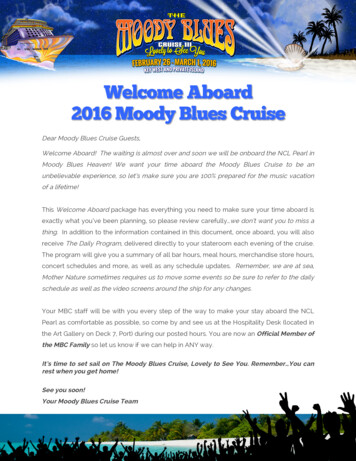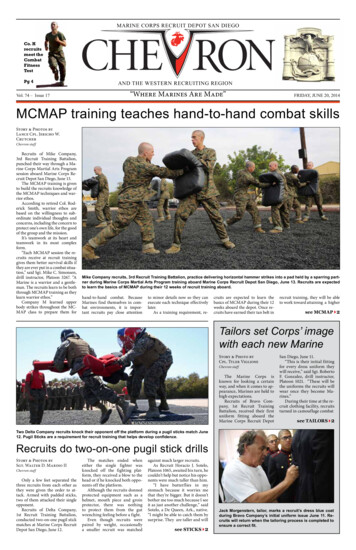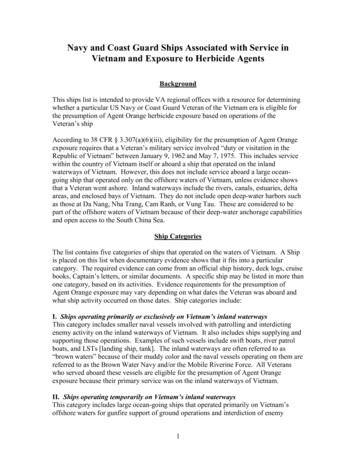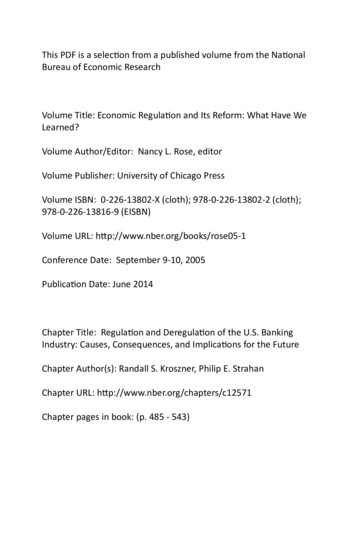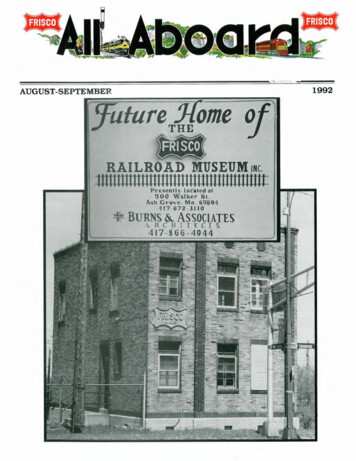
Transcription
AUGUST-SEPTEMBER1992
VOLUME 7August-September, 1992NUMBER 2In this installment of Roster Tales Frisco Folk Ken Wulfert returns tohis discussion of Frisco's diesel yard switcher locomotives. Nos. 10. 11.& 12.Rick's Tips17Frisco Folk Rick McClellan shares with us an assortment of modelingtricks, tips, and neat things to do that are relatively simple, inexpensive,and quick, all of which can enhance the appearance and operation ofyour layout. In this installment Rick reviews improving slow motionswitch machines.DOWN AT THE DEPOT18Menard, TX, on the Ft. Worth & Rio Grande Railway, is the featuredstation in this issue.New Car Shop19In this edition of the New Car Shop Joe Pennington & Frisco Folk MartinLofton share the second of a two part series on Frisco hopper carnumbers, their individual characteristics, and how to model them in HOThe Officers & Board of Directors are pleased to announce that Mr. GeneAutry is one of the newest members of our Frisco Folks family! Thisfeature provides a brief profile of Mr. Autry's days as a telegrapher onthe Frisco.A brief history of the museum is followed by a detailed description,photos, and architectural renderings of the new Springfield, MO facilityand relocation project.Frisco Roster Tales Up-Date13Frisco Folk Bob Plough provides information on twelve Frisco GP35's,rebuilt as GP39E's and GP39M's, currently in service on the BN.ABOUT THE COVEROur cover this issue officially announces the Springfield, MO relocation project,and features a photo of the existing building, built by the Frisco in 1944, for theirC.T.C. Command Center. and the Future Site Of sign to be placed on the propertyin October. The old C.T.C. building will be the new home of the museum'sadministrative offices. See related story and additional photos on pp. 6-11.Alan SchmittCharles E. MahaffeySaundra SchmittWarren HallRichard NapperLouis GriesemerGuy S. PollardAlan SchmittEditorRichard NapperFMIS EditorContributing Editor'sRick McClellan Ken WulfertJoe Pennington Martin LoftonMembership SecretaryRachel SchmittDistributionSarah Schmitt
The Frisco Folks headlinemarked the section in the variouscompany publications that reportedthe activities and accomplishmentsof company employees and theirfamilies. The Frisco was a familyoriented company! The FriscoRailroad Museum Inc. iscontinuing that family tradition inour FRISCO FOLKS supportorganization, for individuals whobelieve in the purpose and objectivesof the museum and are committedto preserving the rich heritage ofthe Frisco. A variety of membershiplevels are offered, as follows:SWITCHMAN: A one yearmembership for a donation of 25.00BRAKEMAN: A two yearmembership for a donation of 50.00.FIREMAN: A three year membershipfor a donation of 75.00.CONDUCTOR: An expanded threeyear membership for a donation of 100.00.ENGINEER: A life membership fora one time donation of 500.00 ormore.The museum is pleased toacknowledge the followingmembership renewals in theFRISCO FOLKS:Jim SpillarsArkansasFrancis LuttrellMichiganWilliam CrightonMissouriJohn F. JonesMissouriSteve & Patty Thiel.MissouriCurt AyersCaliforniaJohn F. Lu ceyCaliforniaPaul manSwitchmanSwitchmanSwitchmanGroege ShayMissouriBill HeissMissouriJohn P. MannOhioJim HartnessArkansasJim QuarlesKansasJan Edward JesterKansasNeal DeChazoOklahomaJames B. HornMichiganAndrew HackmeyerFloridaMike CookTexasDon ALdermanTexasBruce MillinsFloridaLewis MulkinsOklahomaEugene MajerowiczCaliforniaRonald W. WhiteMissouriRobert ChadderdonOklahomaJames A. MottramMissouriJanes KenneyCanadaRon GarlingMissouriRichard AllisonMissouriA. Orman FisherMissouriRaymond MillemannTennesseeArthur LindemanMissouriJames A. witchmanSwitchmanThe museum is pleased to welcomethe following new members to theFRISCO FOLKS:Gene AutryCaliforniaLouis GriesemerMissouriGeorge H. Brandt JrNorth CarolinaSteevffie mfg. CoMissouriMax R. DavisColoradoEd BurkeCaliforniaBrice J. SunderlinMichiganMike O'BrienMissouriGale LoweryKansasBristow Hist. SocietyOklahomaDale WillcocksonMissouriChuck LappMichiganEric Dale BrownMissouriJacob BrownMissouriJoe & Yvonne BohrerMissouriDavid P. LuseWashingtonRussell W. FauknerTexasRobert C. Del GrossoIdahoDonald G. MorganCaliforniaJames BakerMissouriJerry SandersMissouriJason HallArkansasJim LynchArkansasEngineerEngineerDue to seasonal adjustments in visitor traffic and to allowadditional time to devote to developing our new Springfield, MOproperty, beginning September I,the museum's Ash Grove displayfacility will be open Thursday thruSaturday, 10:00 a.m. to 5:00 p.m.The museum office will continue tobe open Tuesday thru Saturday andphonemessages recorded at anytime!
Frisco's Most Famous FolkHe was born Orvon GordonAutry on September 29, 1907,worked for seven years as a telegrapher on the Frisco's SouthwesternDivision, and went on to become aliving legend in the entertainmentindustry. Better known as GeneAutry, he can easily lay claim to thetitle of Frisco's Most Famous Folk.The Officers and Board ofDirectors are honored to announcethat Mr. Gene Autry is one of thenewest members of our Frisco Folksfamily! In A letter, dated August 24,Mr. Autry writes, My days with therailroad taught me quite a lotwhich I was able to use in my lifeand in my career. It was a goodstart for a youngster to have.Your correspondence broughtback some very special memoriesfor me which I will always treasure.Mr. Autry's first exposure tothe railroad occurred when he wasstill in high school at Tioga, TX. Inhis spare time, Gene would smashbaggage and serve as cow nursearound the Frisco depot at Ravia,OK, Station E592 on the ShermanSub-Division, Southwestern Division. In the process, he learned thecode and on June 18, 1925, went towork for the Frisco as AssistantTelegraph Operator at Weleetka, OK,Station E495 on the Creek SubDivision, Southwestern Division.For the next seven years, heAN EX-BRASS POUNDERMAKES GOOD IN RADIOAN EX-BRASS POUNDER MAKESGOOD IN RADIO was the title of thearticle about Gene Autry that, alongwith the above photo, appeared inthe July, 1934, issue of The FriscoEmployes' Magazine.In the letter he expressedhis regret for leaving the Frisco,thanked the company for theiremployment, and hoped that if heever needed another job they wouldconsider employing him.According to Mr. Autry, thelong hours of isolation as a telegraphoperator contributed to his careerin music. I got so blame lonesomethat I decided to try to learn a littlesomething about music. It hadalways been a hobby of mine eversince mu granddad, a Baptistminister, had me sing in his choirwhen I was just a little shaver.did indeed learn a littleHesomething about music, a littlesomething that lead him to becomethe Singing Cowboy, recordinghundreds of songs including two ofthe all time western classics, SilverHaired Daddy of Mine andCowboy's Heaven. Few can forgethis rendition of the Christmasinstitution, Rudolf the Red NoseReindeer.Autry also distinguishedhimself as an actor, staring in anumber of movies in which hecombined his famous cowboy songswith exciting western adventures.In 1952, the Frisco indirectlybestowed an honor on Gene Autry.Following extensive repairs due to acrossing accident in Ft. Scott, KS,diesel passenger locomotive No.2022 was renamed Champion, thename of Autry's famous horse.worked at a total of eight different stations along the Frisco'sOklahoma Southwestern Division, including Vinita, Sapulpa,Catoosa, Snyder, Bristow, Davenport,Schulter, and Henryetta.According to our records, inApril, 1932, he left work as full-timeoperator at Henryetta and neverreturned. On October 14, 1932, hesent the Frisco a letter, on letterheadreading:Gene AutryRadio & Recording ArtistYodeling Blues & Oldtime SongsR.J. Stone, Vice-President of the Frisco, presents Mr. Autry with a telegraph key,replica of the one he used when he worked for the company.1952Frisco photo
Frisco Passenger Locomotive #2022, Champion, so-named in honor of Gene Autry's horse. Frisco photoOn August 20, 1992,our Frisco Folks family lost aspecial member when Clarence B. Pearce, Vice-Presidentand Member of the Board ofDirectors, passed away.Mr. Pearce was born inBolivar, MO and worked forthe Frisco thirty-eight years.He started his railroad careerat the freight house inSpringfield, MO. DuringWorld War II, he supervisedthe movement of a number oftroop trains across the country, and retired from theSpringfield, MO Traffic & SalesDepartment.Following his retirement, Mr. Pearce devoted histime to his garden, his wife offifty-nine years, Louise, andhis family, Alan, Saundra,Rachel, & Sarah Schmitt.Mr. Pearce was a majorforce in the establishment ofThe Frisco Railroad MuseumInc., and his support, encouragement, and guidancewere key factors in the successof the organization. Any timesomeone was needed to watchthe store, Clarence was always there, without fail! Hewas deeply involved in theSpringfield relocation projectand was looking forward toturning the first shovel of dirtand sharing in its completion.For those of us who hadthe opportunity to know, love,and work with Clarence, hiskind & gentle nature, supportive spirit, and love for theFrisco will live on in our heartsas a lasting legacy of a truefriend!
The Dedication of a DreamLadies & gentlemen, weare gathered here today todedicate a dream. That dreamis The Frisco Railroad Museum!So stated museum founder& current president Alan Schmitt,when on June 1, 1986,approximately 150 people gatheredin Ash Grove, MO, to celebrate theopening of The Frisco RailroadMuseum Inc., the first and onlysuch museum in the countrydevoted exclusively to the FriscoRailway.It was appropriate that thededication of a railroad museumwas called the dedication of a dreambecause dreaming and railroadinghave always had a uniquepartnership.Think of all the young boysin early America who dreamed ofbeing the next Casey Jones as theywatched with intrigue those steampuffing monsters called locomotives,rumble down the track. Think of allthe young girls watching a passengertrain roll through a distant field andwondering who the people on boardwere, what exotic and far awaydestinations they were headed for,and dreaming of how exciting itwould be to climb on board.Think about the young menriding the train for the first time anddreaming about how exciting itwould be to call out those familiarwords. All 'board. and feel thetug of a string of passenger varnishbegin yet another journey acrossthe steel ribbon highways ofAmerica.Think about those childrenwho because of the social &economic conditions of the timesfound themselves sitting in arailroad station dreaming of the newlife awaiting them at the end of theirjourney on one of the many orphantrains that traveled across thecountry.Yes, dreaming andrailroading have always had aunique kinship. In 1849, a group ofrailroad pioneers met in St. Louiswith a dream of a railroad thatwould span the western frontier ofAmerica. A railroad that wouldtraverse the plains from thecommerce center of St. Louis to thetide waters of the Pacific at SanFrancisco.In the early 1850's, some ofthose same railroad dreamersenvisioned a southwest branch ofthat line carrying pioneer families,themselves with a dream of startinga new life in the wild and sparselysettled region known as SouthwestMissouri. In 1870, that dreambecame a reality when on April 21,the first train rolled into NorthSpringfield, MO. By the turn of thecentury, North Springfield and itssouthern neighbor affectionatelyknown as Ole Town Springfieldwere united as the hub of railroadingoperations in Southwest Missouri.In 1876, the dream ofanother chapter in America'srailroading history became a realitywhen the St. Louis & San FranciscoRailway Co., better known as theFrisco, was born. While it neverreached its goal of the Pacific Coast,the name remained throughout its104 year history as a mute testimonyto the dreams of those early railroadpioneers.During its tenure ofoperation the Frisco expanded itsservices and facilities into ninestates with over 5,000 miles of mainline track. It's interesting to notethat the name Frisco was in fact acorporate nickname. The FR wastaken from Francisco, the IS fromLouis, and CO for Company. Thefamiliar FRISCO was usuallydisplayed inside an equally familiarcorporate logo, that was patternedafter a raccoon hide supposedlyconfiscated by a company vicepresident off the end of the Neosho,MO depot in the late 1800's.Although the design was changedand modified over the years (see AllAboard, June-July, 1992, p. 5) thename and that familiar coonskinlogo served as the corporate fingerprint of the Frisco throughout itshistory.In November, 1980, theFrisco fell victim to the necessity ofcorporate merger with the Burlington Northern Railroad and manyfolks believed that the memory andheritage of that coonskin railroadwould be lost. Fortunately, theywere mistaken. Those memories.that heritage. that coonskin railroad lives on. and why! Because ofa dream! The dream that wasdedicated on June 1, 1986, as TheFrisco Railroad Museum.In 1970, the museumfounder and current president AlanSchmitt started what would becomea life-long project of collecting thehistory and memorabilia of theFrisco. Over the years that followed, he began to realize the impact the Frisco had on the development of not only SouthwestMissouri, but on every area that itoperated in.Having grown up on thenorth side of Springfield, MO, withinsite and sound of the Frisco shops,and coining from a Frisco family(the grandfather whom he is namedafter, his father-in-law, both of hiswife's grandfathers, and numerousother family members, all workedfor the Frisco), he began to developa deep sense of appreciation for,and kinship to, an organization thatmade a major contribution to theheritage of which he was a modernday benefactor. The Frisco becamemore that just memorabilia andhistory. It was family!As his interests and collection grew, the dream of sharing itwith the public began to develop.When he saw what was happeningto the Frisco following the 1980merger, he started to feel a strongcall to Do something about it!With the encouragement and support of his family, Alan spent thenext few years visiting other museums, studying railroad historicalorganizations, and dreaming.
The end result of those visits,studies, and dreams was theremodeling of a two-car garage intothe likeness of a railroad depot thaton June 1, 1986, was dedicated asThe Frisco Railroad Museum Inc., astate chartered not-for-profit,federal 501 (c)(3) tax exemptcorporation dedicated to thepurpose of Preserving, Displayingand Educating citizens about,the history and memorabilia ofthe Frisco Railway.Since then the memorabiliacollection, historical archives, andprograms & services of the museumhave grown to the point that it isnow being recognized as aprofessional historical organizationthat is the premier repository andresource center of Frisco railwayhistory. Of even more importancehas been the growth of the FriscoFolks, a family of committedsupporters who are the life line ofthe organization and are carryingon the family tradition that was somuch a part of the Frisco.What does the future holdfor The Frisco Railroad Museum? Adream! A new dream! A dream ofexpansion and improvement! Adream whose reality started tounfold in June, 1992 when propertywas graciously provided by theBurlington Northern Railroad toallow the museum to relocate itsfacilities to Springfield, MO, thetraditional hub of Frisco operations.After a year of intense review& evaluation of the growth,programs, and services of themuseum, the examination of ninepotential sites, and the submittingof a proposal to acquire land fromthe BN, on June 12, 1992, themuseum took possession of 29,850sq. ft. of property located at thegateway of the Commercial StreetHistoric District, Springfield, MO.The site is close to thelocation of the first railroad depotbuilt in Southwest Missouri and isidentified by an historic markermaintained by the City ofSpringfield. In 1983, theCommercial Street Historic District(our site included) was placed on theNational Register of Historic Places.Early beginnings of The Frisco Railroad Museum Inc., in Alan Schmitt'sbasement display room, June, 1972.June 1, 1986, Opening day of The Frisco Railroad Museum Inc.500 Walker St, Ash Grove, MOLocated adjacent to the oldEastern Division of the Frisco intoSpringfield, the new property alsoincludes an 1,800 sq. ft. brickbuilding that was originallyconstructed in 1944 to house theFrisco's centralized Traffic Controlcommand center, and is the onlyremaining Frisco-built structure inSpringfield that still displays thefamiliar Frisco coonskin logo castin concrete.Plans are now underway torenovate the existing building toprovide space for the museum'sadministrative offices, archives,publishing department, and photolab.A new 8,000 sq. ft. displayfacility is to be constructed adjacentto the existing building that willhouse a number of full size dioramasprofiling all areas of Friscooperations, facilities, andequipment.The first floor design of thenew facility is based on theSmithsonian concept ofenvironmentally controlled displaydioramas in which the display "case"is a full/scale size replica of a facilityand/ or piece of equipment that ishistorically oriented and visuallyenhances the items on display.The main entrance /lobbyarea walls & appointments willrecreate the interior of a standard
Frisco depot, circa. 1890's, completewith authentic ticket window & grill.As visitors enter the displayportion of the facility, they will firstsee a 29' full scale mock-up of aFrisco wooden passenger car thatwill house a media presentationcenter and general purpose meetingand seminar room.Next, a labyrinth of sixteendisplay cases will trace the historicaldevelopment of the Frisco from the1849 St. Louis convention to the1980 merger. Each case will includea visual record of development inten year segments and will includehistorical profiles and developmentmaps, photos, and relatedmemorabilia for each time period.Additional displays in thisarea will profile specific programsand departments of the Friscoincluding such things as Safety,Training, Sales, Piggyback service,Hospital Association, etc.After leaving the historicaldevelopment area, visitors will enterthe main display corridor that beginswith a display island featuring acollection of switchstands, lamps,and related hardware.Next, Frisco Motor Cartrailer #81, (see All Aboard, AprilMay, 1991, pp.4-6), restored andbuilt into the facility, will house ourPassenger Service displaysincluding mock ups of a Dining Carand Pullman roomette.As visitors move along themain display corridor, on their rightwill be a twenty-one ft. full sizerecreation of a Frisco standarddesign depot that will house a varietyof displays including an agents officeand Railway Express Agency exhibit.Next to the depot will be a twenty ft.replica of a maintenance-of-waysection house that will feature a railvelocipede, Fairmont motor car, anda large assortment of railroad toolsand related memorabilia.Across the isle from thedepot and section house will be athirty ft. mock-up of a wooden boxcar that will house our freightequipment & service memorabilia,photos, diagrams, etc.Next to the box car will be abrick engine house that will houseour motive power displays featuringmemorabilia, photos, and relateditems profiling both Frisco steamand diesel locomotives.The last display on the mainfloor will be a mock-up of an F.T.C.(Frisco Transportation Company)trailer that will include a displayarea for memorabilia and historicalitems from the Frisco's truck & buslines.A 2,400 square ft. secondlevel mezzanine (overlooking themain display area) will be devotedentirely to model railroading.Although detail plans for this areawill be developed later, at least threeoperating layouts are now planned.One will be for general audienceviewing and the other two will beclub type layouts that will allow ourmodeling members the opportunityto work on the layouts and run theirequipment. One is to be in HOScale and the other in N Scale.A walk-way will extend fromthe second floor mezzanine, acrossthe main display floor, to anobservational deck along the backof the building that will allow an unobstructed view of trains travelingalong the old Frisco Eastern Divisiontracks behind the facility. Thisdeck will also serve as a cover forfuture rolling stock acquisitions thatwill be displayed on the groundlevel below.Both display levels will befully handicap accessible, includingthe observation deck.Visitors will exit the facilitythrough a large gift shop that willfeature quality souvenir items,authentic railroad memorabilia, anda full line of model railroadingsupplies including such services asspecial ordering, custom painting,and train repair. The full range ofmodel railroad supplies & servicesoffered by the gift shop will bedetermined primarily by ourmodeling members needs andwants. All members will receive adiscount on all items purchased inthe shop.To the front of the newdisplay facility, and to the west ofthe administrative office building,will be a court-yard type gatheringarea that will included our FriscoCaboose #1139, various outsidedisplays, and nine flag poles witheach flying the flag of one of the ninestates in which the Frisco operated.In addition, a small fencedplayground area will be includedbetween the buildings to providerecreation for our young visitors.Although the new locationand facilities will provide muchneeded space and more convenientaccessibility for the public, of evenmore significance will be theopportunity it represents forperpetuating a significant part ofAmerica's railroad history and therole it will play in the preservation,display, and education of citizensthrough the country, about the richand colorful history of the Frisco!Included in the June, 1986,dedication ceremony was thestatement, Yes, we are here todedicate a dream, but we arealso here to dedicate amemorial. a living memorial toall those dedicated men andwomen who through the yearshave proudly been a part of thatspecial family known as theFrisco!In his The Collector's Bookof Railroadiana, Stanley Bakerobserved, I have often thought tomyself, 'What would America havebeen like if there had been no trains?Someone once said, 'I can no moreconceive of a world without railroadsand trains to run on them that I canimagine wishing to live in such aworld.' An appropriate modificationof that statement could read, Icannot conceive of a world withoutsome evidence that there was oncea Frisco Railway, and because of adream. a dream of the past. adream of the present. a dream ofthe future. thankfully, I won't havetoes
New museum site lookingeast. Property runs fromutility pole to left of picture,east 200 ft., to corner.Site of new museumproperty looking west,showing corner location ofexisting building.Site of new museumadministrative offices,research center, &publishing department.Notice Frisco Lines logo onfront of building.
FIRST FLOOR PLAN
SECOND FLOOR PLAN
YARD POWERPART THREELet's continue our promiseddiscussion of the Frisco's diesel yardswitcher locomotives. There werethree individual units included inthe roster of Frisco diesel switchersthat were unusual for a number ofreasons, a major one being thatthey were unique on the Frisco roster- there were no other units everrostered by the Frisco that matchedthem. These three singles were, inorder of their date of appearance onthe roster, the GE 300HP 45-tonSLSF 11, the GE 500HP 70-tonSLSF 12, and the EMD 600HP SW1SLSF 10.Prior to our discussion ofthe three unique members of theFrisco diesel family, a briefqualification should be noted. TheFrisco did have two other examplesof single diesel locomotives whichare not included in this issue ofRoster Tales. There was SLSF 3, A44-ton Whitcomb, which I excludedas it was very similar to the Frisco'sother 44-ton units, SLSF 1 & 2, fromDavenport, and SLSF 4 thru 8,which were fom GE. We'll cover allof them in a future Roster Tale.There also was AT&N 12 (Alabama,Tennessee, & Northern), a GE500HP 80-ton unit. I excluded thissingle since it was never added tothe Frisco roster after the AT&Nwas acquired.SLSF 11 came to the Frisco whenthe AT&N was added to the systemin 1948, providing the Frisco withaccess to the port of Mobile, AL, andto Blakeley Island, across from themain port. This was truly anunusual unit - a GE 45-ton centercab light duty switcher, with 300HP,supplied by two Cummins dieselengines mounted fore & aft of theSLSF 11, in service at Mobile, AL, May 19, 1967. A. Johnson collectioncab. It had two four-wheel trucks,but only one traction motor pertruck. Thus, the wheels and axleson each truck were linked togetherby connecting rods. This unusualarrangement was utilized since thetraction motors were geared to avery low ratio. This gave the 11 Spot,as this somewhat unattractive littlelocomotive was called, a healthy bitof starting tractive effort, in factmore than the GE 44-ton units,which had higher horsepower. TheAT&N bought this unit (as AT&N 1I)in 1941. It spent its entire time inservice for the AT&N and SLSF atone location - on Blakeley Island atMobile, where it switched the carfloats and terminals there servingthe port. This unusual unit wasneeded because of the light track onthe island.It spent all of its career onthe Frisco painted black with yellowtrim & lettering. The only evidenceof Frisco ownership was a smallFrisco coonskin carried on the cabbelow the windows. The 11 Spotgave good, reliable service for almostthirty-eight years, and was retiredfrom service and sold in 1979. Itwas replaced by SLSF 10.The Pinto, shown above, along with the Blakeley, were the two car ferries usedby the AT&N and Frisco between Mobile and Blakeley Island. The Blakeley wasplaced in service January, 1950, and the Pinto went into operation in September,1953.Wayne Porter photo
SLSF 12 was also unusual in thatit had a very short career on theFrisco, as opposed to SLSF 11. Thisunit was a single engine, 500HP GE70-ton, end cab light switcher,which came to the Frisco as ON 7when the Frisco acquired theOkmulgee Northern Railroad in1964.EDITOR'S NOTE: The OkmulgeeNorthern Railroad was a twelvemile short line betweenOkmulgee, OK and ON Junctionwhere it connected with theKansas, Oklahoma, & GulfRailroad. The Frisco connectedwith the KO&G at Henryetta andthe ON at Oklmugee.In the early diesel days, theFrisco used several light dieselswitchers, as noted at the beginningof this article, with somewhat mixedresults. But, in 1964 they simplyno longer had any use for lightswitchers like SLSF 12. Thus, afteronly a year on the roster, most ofthat in storage, the GE 70-tonnerwas sold in 1965.SLSF 12 was unique in thatit was painted light blue with awhite frame and all lettering inyellow. I have seen an excellentmodel of it using the Bachmann GE70-ton model in HO scale.SLSF 10, as you might suspect bynow, also had a number of unusualquirks besides being the singleexample of a 600HP EMD SW1switcher on the Frisco roster. SLSF10 was purchased from the usedlocomotive market and rebuilt in1979 as replacement power for useon Blakeley Island, being lightenough yet more powerful than ourold friend 11 Spot. It started life in1941 on the Great Northern as GN5103, becoming GN 77 in 1943 andBN 77 in 1970. It was then movedoff to a BN subsidiary, the WallaWalla Valley Railroad, in 1971, asWWV 77, and was discarded to theused market in 1978. In 1979, theFrisco rebuilt and modernized it,gave it the Frisco Mandarin Orange& White paint scheme, and, asnoted, placed it in service onON 7 in service on the Frisco at Okmulgee, September, 1964. Frisco photoSLSF 12 in service at Springfield, MO, December 1964. A. Johnson photoSLSF 1O fresh from paint shop, Springfield, MO, 1979. Wayne Porter photo
Blakeley Island as SLSF 10. Proving that many thingsin life come full circle, SLSF 10 returned to the BNroster as part of the SLSF/ BN merger in 1980, when itbecame BN 70. It continues to work the car floats onBlakeley Island today.I was able to see SLSF 10 in Springfield duringits rebuild in 1979, and was impressed with howmodern and attractive this little 1941-vintage switcherappeared. In 1981, it was painted back into BNcolors.Frisco Folk Bob Plough of Springfield, MOhas written with some additional information onthe SLSF diesel roster as it exists today after theBN merger. (see Roster Tales, June-July 1992)In Ken's ten-year SLSF diesel roster, he lists theex-SLSF GP35's as gone from the BN roster. Thisisn't entirely correct. While no longer rosteredas GP35's, the following units were rebuilt asGP39E's and GP39M's by EMD and MorrisonKnudsen, respectively, and, thanks to theirrebuilding, these Frisco veterans should beactive on the BN for many years.Bob then provided a listing of the rebuilds,which occurred in 1990-91, as follows:SLSF/BN GP35 ROAD 80SLSF GP35 701, new at EMD, March, 1964.Frisco photoREBUILT BN NUMBER & TYPE2935 - GP39E2923 - GP39E2908 - GP39E2883 - GP39M2912 - GP39E2911 - GP39E2905 - GP39E2921 - GP39E2900 - GP39E2915 - GP39E2918 - GP39E2924 - GP39EBob also pointed out that I identified the BN3100 class GP5O's incorrectly as GP50-2's. Thelocomotives should be simply noted as GP5O's as Bobsuggests.SLSF GP35 701, in service at Springfield, MO,August, 1972.Walter Evans photoThanks, Bob! Any UP-DATES and corrections topast and future Roster Tales from our readers arealways welcome. Kee
ent stations along the Friscos Oklahoma Southwestern Divi-sion, including Vinita, Sapulpa, Catoosa, Snyder, Bristow, Davenport, Schulter, and Henryetta. According to our records, in April, 1932, he left work as full-time operator at Henryetta and never returned. On October 14, 1932, he sent the Frisco a letter, on letterhead reading: Gene Autry
